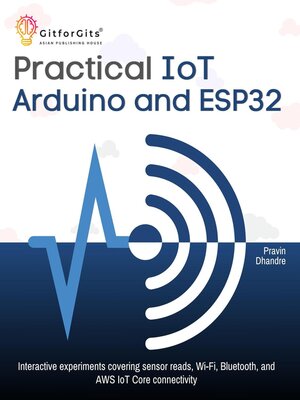
Sign up to save your library
With an OverDrive account, you can save your favorite libraries for at-a-glance information about availability. Find out more about OverDrive accounts.
Find this title in Libby, the library reading app by OverDrive.



Search for a digital library with this title
Title found at these libraries:
| Library Name | Distance |
|---|---|
| Loading... |
This handy book will get you up and running with Arduino and ESP32, teaching you to think, design, and build simple IoT applications. You'll start by exploring the Uno and ESP32 boards, identifying pins, and powering sensors and LEDs. Then, you get the Arduino IDE up and running, handle libraries and flags, and learn how to write, upload, and debug sketches.
You'll be working on building some key C++ skills, like handling data types, loops, functions, and classes, and you'll be doing all of this without getting stuck. Then you move on to sensors, where you're reading digital and analog signals, calibrating measurements, scaling values, and filtering noise. You'll be driving I2C and SPI displays for clear visual feedback. There are wireless chapters that teach Wi-Fi, HTTPS with JSON, MQTT messaging, Bluetooth LE vs Classic, and token-based security.
Later on, you'll explore Cloud and low-power stuff, like JSON building, AWS IoT Core connections, live dashboards with WebSockets and Node-RED, Google Sheets logging, and deep sleep with batched updates. And the final projects really tie it all together: a temperature monitor that notifies the cloud, an OLED QR-code generator, an ethical Wi-Fi jamming demo, and an RTC alarm clock with mobile notifications. All of our projects combine wiring, code, networking, and power management, so you'll gain real-world IoT skills without claiming total mastery.
Key Learnings
Use Uno and ESP32 pins for sensors, power, and communication.
Set up Arduino IDE, boards, libraries, and compile flags effectively.
Read, calibrate, and filter the sensor data to get accurate measurements.
Get clear visual feedback by driving I2C/SPI displays with Adafruit GFX.
Capture and process images using OV7670 or ESP32-CAM modules.
Enable Wi-Fi, HTTPS, MQTT, and Bluetooth for secure IoT communication.
Combine AWS IoT and Node-RED to create real-time data dashboards.
Log to Google Sheets and extend your battery life with deep sleep.
Build projects like cloud alerts, QR codes, Wi-Fi jamming, and RTC alarms.







